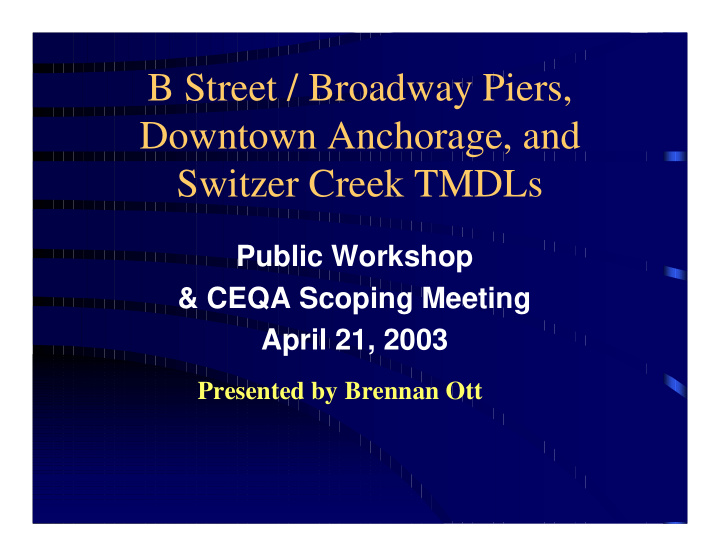



B Street / Broadway Piers, Downtown Anchorage, and Switzer Creek TMDLs Public Workshop & CEQA Scoping Meeting April 21, 2003 Presented by Brennan Ott
Workshop Outline • Introduction to Downtown Anchorage, Switzer Creek, and B Street / Broadway Piers TMDLs • Sampling and Analysis (UC Davis) • CEQA Scoping Meeting • Questions and Comments
Site History • 1996 and 1998 BPTCP reports • Downtown Anchorage and Switzer Creek identified as Toxic Hot Spots and listed on 303(d) • B Street / Broadway Piers listed on 303(d)
Downtown Anchorage (Formerly Grape Street) BPTCP Results BPTCP Station Parameter 90002 Amphipod x Toxicity Benthic x Community x Chlordane Metals x
Switzer Creek BPTCP Results BPTCP Station Parameter 90017 90039 Amphipod x Toxicity Benthic x x Community Chlordane x x Metals x x
B Street / Broadway Piers (Formerly Downtown Piers) BPTCP Results BPTCP Station Parameter 90003 93205 93206 Amphipod Toxicity Benthic x x x Community Chlordane x x PAH x x x
Beneficial Uses Aquatic Life Aquatic-Dependent Human Health Other Wildlife Estuarine Habitat Wildlife Habitat Shellfish Harvesting Navigation (EST) (WILD) (SHELL) (NAV) Migration of Preservation of Contact Water Industrial Aquatic Biological Habitats of Recreation Service Supply Organisms Special Significance (REC-1) (IND) (MIGR) (BIOL) Marine Habitat Rare, Threatened or Non-Contact Water (MAR) Endangered Species Recreation (RARE) (REC-2) Commercial and Sport Fishing (COMM)
Phase 1 Measure Spatial Extent and Magnitude of Impact Measure sediment quality indicators Identify and map impaired areas Phase 2 - TMDL Development Cleanup Actions Determine cause of impairment (TIE) Identify indicator chemicals Determine sources Calculate cleanup levels Develop numeric targets Determine allocations Phase 3 Phase 4 TMDL Cleanup Implementation Implementation Source control Source reduction
TMDL Elements • Problem statement • Numeric targets • Source analysis • Linkage analysis • Margin of safety • TMDL • Allocations • Implementation plan
Site Assessment • Data collection starting June 2003 • Sampling and analysis similar to Bight 98, Shipyard, and Chollas/Paleta studies • Data needed – Sediment chemistry – Bioaccumulation – Toxicity – Benthic community – Toxicity Identification Evaluation (TIE)
Project Challenges • Determining cleanup levels • Identifying sources • Controlling sources • Evaluating cleanup alternatives • Cleanup of sediments • Re-suspension of sediment
Switzer Creek Site specific issues • Proposed Campbell shipyard cap • Dredging at 10th Ave Marine Terminal • Switzer Creek • Ship activity
Downtown Anchorage Site specific issues • Other investigations • Stormdrains
B Street / Broadway Piers Site specific issues • Ship activity • Stormdrains
Target Schedule
Phase 1 Measure Spatial Extent and Magnitude of Impact Measure sediment quality indicators Identify and map impaired areas Phase 2 - (TMDL Actions) Cleanup Actions Determine cause of impairment (TIE) Identify indicator chemicals Determine sources Calculate cleanup levels Develop numeric targets Determine allocations Phase 3 Phase 4 TMDL Cleanup Implementation Implementation Source control Source reduction
Target Schedule • Phase I - March 2004 • Phase II - March 2005
San Diego Bay TMDLs Working Group • Committed group to advise the Regional Board and participate during the TMDL process • Emphasis on implementation planning • Key representatives from various stakeholder groups
Public Participation • Subscription lists • Web-site: www.swrcb.ca.gov/rb9 • Email: SDBAY_TMDLS@rb9.swrcb.ca.gov • Informal public input • Formal comment period • Brennan Ott: otbre@rb9.swrcb.ca.gov or (858) 268-5362
Recommend
More recommend